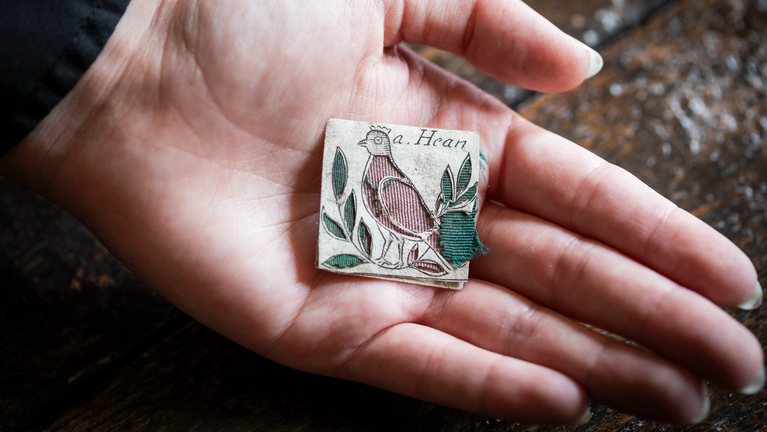Lost by Schoolgirls: A display of 17th century papercuts
- Published:
- 15 July 2024

Rare survivals of decorative paper cutting by schoolgirls nearly 350 years ago have been found under floorboards at Sutton House.
Originally built for one of Henry VIII’s statesmen, Sutton House has been used for a variety of purposes over the years, becoming a school in the 17th century. During this time, it’s thought that paper shapes cut out by schoolgirls slipped through gaps in the floorboards, remaining undiscovered until now.
The paper-cuttings will be on display at Sutton House from Friday 19 July until June 2025.
Making the discovery
During renovation works in the late 1980s, hundreds of items found under floorboards were carefully stored away. These finds remained uncatalogued for over 30 years until last year, when a team of volunteers began to sort through bags of centuries-old builders’ rubble, discarded textiles, paper and bones and other objects which had been lost over time.
Among the finds volunteers discovered a small number of delicate cut-out paper designs, only a few centimetres in size. Eight of these have been dated to the late seventeenth century when papercutting as a pastime in the UK was in its infancy and are extremely rare survivals.
The discoveries include an intricate folded paper star, hand-coloured cut-outs of a fox, and a female figure bathing, and a hen with added green and pink silk embellishment, along with black and white cut-outs of a bird and a country couple in clothing of the period.

A 17th century art form
Girls and women in the 17th century were taught a number of crafts including embroidery, needlework and papercutting. They would cut out the tiny designs from books filled with themed designs, using tiny pairs of scissors, knives and even pins. They’d often be coloured in by hand using watercolours and use as decoration on boxes and other items.
Dr Isabella Rosner, an expert in early modern material culture, identified the paper cuttings at Sutton House which are almost identical to only two other known surviving examples, one of which is a decorative box dating to the 1680s held in a collection at Witney Antiques in Oxfordshire. The prints found underneath the Sutton House floorboards are hugely exciting, as they give us glimpses into the rich material world of middle and upper-class schoolgirls 350 years ago.
Paper cutting for decoration was a subject in various household management books for women in the seventeenth century, notably by Hannah Woolley, such as ‘A Guide to Ladies’ (1668) and ‘The Gentlewoman’s Companion’ (1673). She described the ‘cutting of Prints, and adorning Rooms or Cabinets, or Stands with them,’ as skills which ‘I shall be willing to impart to them, who are desirous to learn.’”
Sutton House
Built in built in 1535 by Sir Ralph Sadleir, this Tudor home reveals five centuries worth of history, creating vivid snapshots into the past. The garden, known as the Breaker's Yard, includes playful features which celebrate the garden’s former life as a car scrapyard.
You might also be interested in

Things to see and do at Sutton House
One of London’s last remaining Tudor houses, Sutton House was built in 1535 by Sir Ralph Sadleir as his family home, and is now the oldest house in Hackney. Explore its atmospheric Tudor rooms with their original features and discover its surprising recent history.

History of Sutton House
Discover the history of Sutton House, the oldest home in Hackney. Explore its colourful past through the people who lived and worked here, from wealthy merchants to squatters.

Our work at Sutton House and Breaker’s Yard
Discover how Sutton House and Breaker’s Yard, London, works with its local community and the tasks involved in conserving this special place.

Volunteering opportunities at Sutton House and Breaker's Yard
Find out about volunteering at Sutton House and Breaker’s Yard. With opportunities inside and out, there’s a range of roles at this special place.

Venue hire at Sutton House and Breaker’s Yard
From exhibitions & performance to meetings, 16th-century Sutton House is the perfect venue for a whole host of events. Choose from a range of unique and historic rooms.